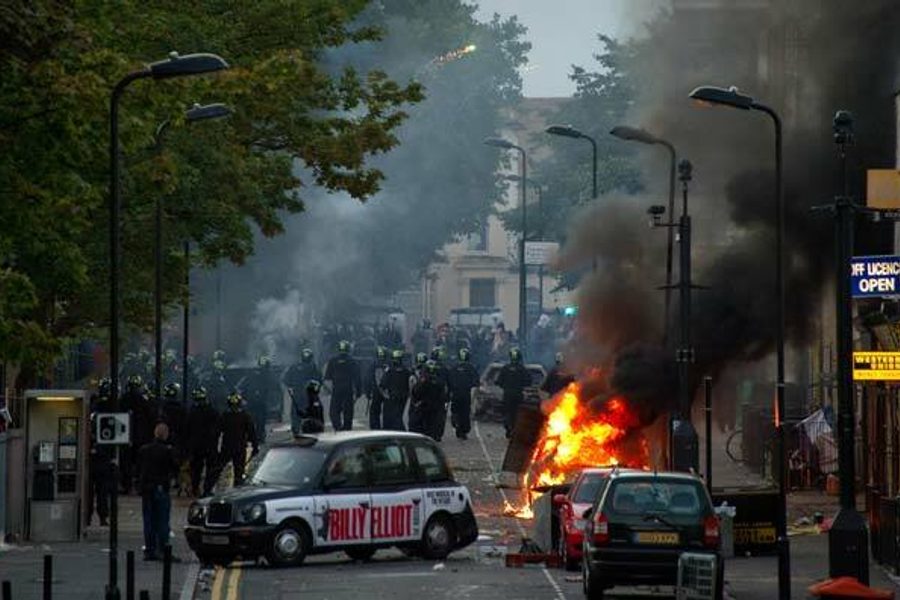
The Riots, Communities and Victims Panel released its final report yesterday on the August 2011 UK riots, concluding, “after the riots, we must give everyone a stake in society.”
The panel, appointed by British Prime Minister David Cameron to examine the August riots that Scotland Yard described as the worst urban violence in the UK in living memory, focused on the country’s “500,000 forgotten families,” arguing that a lack of institutional support for young people, as well as poor parenting, were among the factors that led to rioting in Birmingham, London Manchester and other English cities. Darra Singh, Chair of the Riots Communities and Victims Panel, said in a press statement:
There are people ‘bumping along the bottom’, unable to change their lives. When people don’t feel they have a reason to stay out of trouble, the consequences for communities can be devastating – as we saw last August.
The report estimates that up to 15,000 people, most of them under the age of 24, participated in the riots.
On broad youth participation in the riots, the report notes:
We heard from many communities who feel that rioter behaviour could ultimately be ascribed to poor parenting. We need to consider what can be done to ensure that all children get the right support, control and guidance from parents or guardians to give them the best possible chance of making the most of their lives.
Among the panel’s recommendations are a “Youth Job Promise” scheme funded by government and local public services to help youth who have been unemployed for more than a year; greater support for troubled families, including specially-trained nurses to offer advice to teen mothers; penalties for schools that fail to teach children to read; and the involvement of primary and secondary schools in “undertak[ing] regular assessments of pupils’ strength of character.”
While the report noted that more than half of the 1,200 people it interviewed in affected areas believed that there was a “growing gap between rich and poor” in their neighborhood, the recommendations focused primarily on how to reintegrate “forgotten families” into mainstream society.
State-sponsored reports on riots have an interest in making riots appear to be spontaneous episodes unlikely to occur again — and therefore, in portraying rioters as a marginal element motivated by criminality rather than grievances shared by the broader society. The Riots Communities and Victims panel’s emphasis on “a lack of shared values and sense of responsibility” holds echoes of the McCone Commission report, which was convened to study the 1965 Watts riots in Los Angeles. That commission’s report, which characterized the rioters as a delinquent group unrepresentative of African-Americans, and the riots as unrelated to conditions in urban slums, was quickly challenged by the California Advisory Committee to the United States Civil Rights Commission.
While the McCone Commission based many of its findings on the impressions of the mayor, chief of police and other officials, academic studies done afterwards showed that African-Americans in Los Angeles who had not participated in the riots were broadly supportive of them, and that the majority of blacks in the Watts area reported that they felt increased pride as a result of the riots.
In testimony taken by the McCone Commission and later released, participants in the riots and observers in the Watts area reported that after the events that took place: “We were whole people, not just servants;” and “It was the metamorphosis of the Negroes of southeastern Los Angeles from victims – historical objects – to masters.”
So when is a riot a “riot,” and when is it actually a revolt?
Even when violent or ultimately self-destructive, riots are most usefully understood as a political act that highlight inequality and discrimination.
Though blame for the UK riots quickly shifted to poor schools and poor parenting, the unrest began in Tottenham – a crowded south London neighborhood inhabited by a mix of British-born African-Caribbeans, Turkish, Portuguese and Somali peoples — over the police killing of Mark Duggan, an unarmed black youth.
As Hal Austin, a Barbadian who lives in London, recounted after the riots began, there is a long history of police violence in Britain’s minority neighborhoods — and a long history of riot reports that overlook the underlying problems:
The simple message to get out is that police and the black and youth community are not on good terms…Those of us who have been around before and since the national explosion in 1980/81, and again in 1985 in Broadwater Farm, know full well the lessons had not been learned. After the 1981 riots we got the Scarman report, and the Police and Criminal Evidence Act, and were told it would never happen again. After the 1985 Broadwater Farm uprisings we had the unofficial Gifford Inquiry and again were told it would never happen again. Then we got the farce of the Stephen Lawrence murder inquiry, the hypocrisy of the Daily Mail intervention and the Macpherson report, all added to the diversion of the national debate about race relations and policing.
The role of police violence, however, is generally reduced in the Riots Communities and Victims report to an emphasis on “increasing trust in the police.” While the report acknowledges that the Tottenham riots began in response to Duggan’s death and recommends that the Independent Police Complaints Commission and police “urgently review their existing protocols,” this is presented mainly as a way to challenge the “deliberate false rumours and unintended inaccuracies” that could spark unrest again in the future.
One clear lesson of the riots, according to Austin, is “social breakdown that can take place when the police force has become an invading army, using paramilitary tactics, and has lost the trust of the people it is meant to serve.”
Rebecca Burns is an In These Times contributing editor and award-winning investigative reporter. Her work has appeared in Bloomberg, the Chicago Reader, ProPublica, The Intercept, and USA Today. Follow her on Twitter @rejburns.





